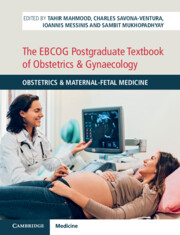Book contents
- The EBCOG Postgraduate Textbook of Obstetrics & Gynaecology
- The EBCOG Postgraduate Textbook of Obstetrics & Gynaecology
- Copyright page
- Dedication
- Contents
- Contributors
- Preface
- Section 1 Basic Sciences in Obstetrics
- Section 2 Early Pregnancy Problems
- Section 3 Fetal Medicine
- Section 4 Maternal Medicine
- Section 5 Intrapartum Care
- Chapter 43 Normal Labour
- Chapter 44 Issues during Labour for Migrant Populations
- Chapter 45 Prolonged Pregnancy
- Chapter 46 Induction of Labour
- Chapter 47 Intrapartum Fetal Monitoring
- Chapter 48 Augmentation of Labour
- Chapter 49 Analgesia and Anaesthesia during Labour
- Chapter 50 Preterm Labour
- Chapter 51 Management of Multiple Pregnancy during Labour
- Chapter 52 Abnormal Obstetric Presentation
- Chapter 53 Intrapartum Emergencies
- Chapter 54 Caesarean Section
- Chapter 55 Instrumental Operative Obstetrics
- Chapter 56 Maternal Collapse in Labour
- Chapter 57 Management of Postpartum Haemorrhage
- Chapter 58 Birth Injuries and Perineal Trauma
- Chapter 59 Management of Stillbirth
- Section 6 Neonatal Problems
- Section 7 Placenta
- Section 8 Public Health Issues in Obstetrics
- Section 9 Co-Morbidities during Pregnancy
- Index
- Plate Section (PDF Only)
- References
Chapter 46 - Induction of Labour
from Section 5 - Intrapartum Care
Published online by Cambridge University Press: 20 November 2021
- The EBCOG Postgraduate Textbook of Obstetrics & Gynaecology
- The EBCOG Postgraduate Textbook of Obstetrics & Gynaecology
- Copyright page
- Dedication
- Contents
- Contributors
- Preface
- Section 1 Basic Sciences in Obstetrics
- Section 2 Early Pregnancy Problems
- Section 3 Fetal Medicine
- Section 4 Maternal Medicine
- Section 5 Intrapartum Care
- Chapter 43 Normal Labour
- Chapter 44 Issues during Labour for Migrant Populations
- Chapter 45 Prolonged Pregnancy
- Chapter 46 Induction of Labour
- Chapter 47 Intrapartum Fetal Monitoring
- Chapter 48 Augmentation of Labour
- Chapter 49 Analgesia and Anaesthesia during Labour
- Chapter 50 Preterm Labour
- Chapter 51 Management of Multiple Pregnancy during Labour
- Chapter 52 Abnormal Obstetric Presentation
- Chapter 53 Intrapartum Emergencies
- Chapter 54 Caesarean Section
- Chapter 55 Instrumental Operative Obstetrics
- Chapter 56 Maternal Collapse in Labour
- Chapter 57 Management of Postpartum Haemorrhage
- Chapter 58 Birth Injuries and Perineal Trauma
- Chapter 59 Management of Stillbirth
- Section 6 Neonatal Problems
- Section 7 Placenta
- Section 8 Public Health Issues in Obstetrics
- Section 9 Co-Morbidities during Pregnancy
- Index
- Plate Section (PDF Only)
- References
Summary
Medical interest in labour induction has existed since the time of Hippocrates. This interest may have originated from both scientific curiosity and the innate fear of every obstetrician of experiencing a term stillbirth. The utilization of oxytocics was initiated in obstetric practice with its treatment for postpartum haemorrhage but later was employed for labour induction. In many countries the frequency of labour induction has doubled over the past three decades. Post-dates pregnancies are the commonest reason for induction of labour. Accordingly, a dating scan is crucial for high-quality antenatal care to assess growth and establish an accurate expected date of delivery. Advanced maternal age is increasingly becoming another common indication for induction of labour (IOL). Besides post-dates pregnancy and advanced maternal age, there other valid reasons for IOL; however, obstetricians need to apply judicious clinical judgement and evidence-based medicine to justify intervention by IOL as the preferred option to the continuation of pregnancy and allowing spontaneous onset of labour to occur. Antenatal surveillance has expanded significantly and can not only be applied to high-risk pregnancies but can also be employed in low-risk pregnancies. Undoubtedly there lies a grey area between the benefit of IOL as opposed to the safe continuation of a pregnancy; however, the obstetrician has the means at hand to appropriately evaluate the likelihood of a successful outcome.
- Type
- Chapter
- Information
- The EBCOG Postgraduate Textbook of Obstetrics & GynaecologyObstetrics & Maternal-Fetal Medicine, pp. 381 - 388Publisher: Cambridge University PressPrint publication year: 2021

